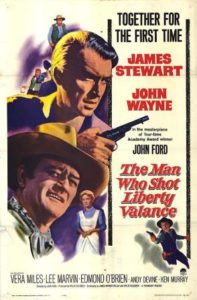 “I know those law books mean a lot to you, but not out here. Out here a man settles his own problems. —Tom Doniphon (John Wayne) to Ransom Stoddard (James Stewart)
“I know those law books mean a lot to you, but not out here. Out here a man settles his own problems. —Tom Doniphon (John Wayne) to Ransom Stoddard (James Stewart)
The Man Who Shot Liberty Valance is a milestone film in a number of ways. Although receiving poor reviews and a disappointing box office on its initial release, it is now regarded as one of the last great Westerns and one of John Ford’s masterpieces. Peter Bogdanovich goes so far as to proclaim it the last film of Hollywood’s golden age, albeit an anachronistic leftover. Further, in its status in the Ford legacy, Liberty Valance was his last great film, his last black and white, the last where his declining health didn’t impair his artistry and the last one to eventually make money. Ford would direct only three more films that were entirely his.
Black and white had become passé by 1962. The public was becoming used to color. The studio, Paramount, wanted it in color. Cinematographer William Clothier, a Western specialist, who also shot Ford’s Fort Apache, The Horse Soldiers, Donovan’s Reef and Cheyenne Autumn, preferred color. Bogdanovich theorized that the makeup necessary to age James Stewart and Vera Miles in the beginning and end of the film would be more convincing in B&W than in color.
Ford’s insistence on B&W was because, he said, the climactic shootout between a firearm novice and the arch-villain of the title, upon which the whole story hinges, would be more dramatic and effective in B&W. After the scene was filmed, Clothier admitted his boss was right: “He knew more about photography than any man who ever worked in the movies.”
In some respects Liberty Valance is a typical Ford film, in others it is not. Unusually, it is almost entirely studio-bound—no picturesque landscape expanses, no backdrops of Ford’s favorite location, Monument Valley, no racing stagecoaches or thundering cavalry charges. As Westerns go, there are no Indians. If it is more ambiguous than most Ford endeavors, it is also darker, as his Westerns were gradually becoming, in a sense a tragedy, a tale—and the success of one character’s life—built on a lie.
 Here, as with most John Ford films, there is the continuing array of his repertoire players. Some of the old familiars may be absent—Victor McLaglen, Harry Carey, Jr., Olive Carey, Ken Curtis, Ben Johnson, Mildred Natwick, Paul Fix, Ward Bond, Hank Worden, Russell Simpson, Arthur Shields and Frank McGrath—but another team of Ford’s reliables take their place: John Qualen, John Carradine, Jeanette Nolan, Willis Bouchey, Carleton Young, Woody Strode, Anna Lee and O. Z. Whitehead.
Here, as with most John Ford films, there is the continuing array of his repertoire players. Some of the old familiars may be absent—Victor McLaglen, Harry Carey, Jr., Olive Carey, Ken Curtis, Ben Johnson, Mildred Natwick, Paul Fix, Ward Bond, Hank Worden, Russell Simpson, Arthur Shields and Frank McGrath—but another team of Ford’s reliables take their place: John Qualen, John Carradine, Jeanette Nolan, Willis Bouchey, Carleton Young, Woody Strode, Anna Lee and O. Z. Whitehead.
Among the six top-billed stars, besides Ford’s most prolific player, one John Wayne, James Stewart had appeared the year before in Ford’s Two Rode Together; Vera Miles was in The Searchers in 1956; newcomer Lee Marvin came on the recommendation of Wayne—the two had worked together in The Comancheros in 1961—and would resurface in Donovan’s Reef; Edmond O’Brien, among the lot, was the only one-time Ford player; and, of the husky voice, Andy Devine had appeared in 1939 in Ford’s Stagecoach.
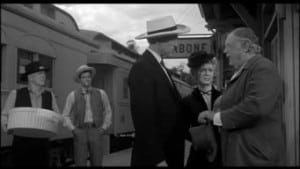 Liberty Valance is, as Ford biographer Scott Eyman called it, a “memory play,” told in flashback by Ransom Stoddard (Stewart), who arrives by train to attend the funeral of old friend Tom Doniphon (Wayne) and to relate the true story, unrevealed these twenty-five years, about who actually shot Liberty Valance (Marvin). (For a review of Eyman’s book, Print the Legend, The Life and Times of John Ford, see this site here.)
Liberty Valance is, as Ford biographer Scott Eyman called it, a “memory play,” told in flashback by Ransom Stoddard (Stewart), who arrives by train to attend the funeral of old friend Tom Doniphon (Wayne) and to relate the true story, unrevealed these twenty-five years, about who actually shot Liberty Valance (Marvin). (For a review of Eyman’s book, Print the Legend, The Life and Times of John Ford, see this site here.)
Perhaps of note, the train that brings Stoddard to Shinbone, the town of his earlier life and scene of the shooting, is the first image on screen, approaching right to left; at the end of the film, when the tale is told, the train, now the final image, is departing left to right.
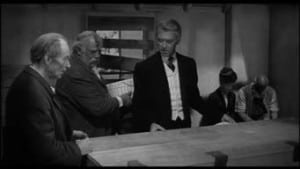 In viewing Doniphon in his wooden box, Stoddard is accompanied by his wife Hallie (Miles) and the town marshal, Link Appleyard (Devine). They find Doniphon’s old ranch hand Pompey (Strode) already watching over the coffin. Stoddard insists the dead man’s boots, gun belt and spurs be put on the body.
In viewing Doniphon in his wooden box, Stoddard is accompanied by his wife Hallie (Miles) and the town marshal, Link Appleyard (Devine). They find Doniphon’s old ranch hand Pompey (Strode) already watching over the coffin. Stoddard insists the dead man’s boots, gun belt and spurs be put on the body.
One of the newspaper men, Maxwell Scott (Young), says he has a right as a reporter to the story, why Stoddard, now a U.S. senator, has returned for the burial of a simple cowboy. Stoddard replies, “Yes, I guess you have [the right].” Stoddard and the reporter move into the next room, leaving the other three mourners with the coffin. Hallie is sitting with the hat box she had with her when Appleyard took her in a buckboard to Tom’s burnt-out cabin where a patch of cactus rose plants was still growing.
Seeing an old, battered stagecoach in the next room, Stoddard is reminded of how his life in Shinbone began. Rubbing off some of the dirt and dust, he realizes it is the same stagecoach that brought him to town—and thus begins the flashback of his story. . . .
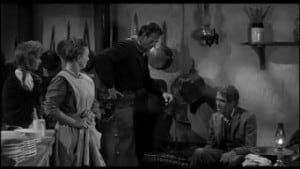 After being robbed and severely beaten by Liberty Valance and his gang (Strother Martin and Lee Van Cleef) during a stagecoach holdup, tenderfoot lawyer Stoddard is taken by Doniphon to a restaurant where the man-and-wife owners (Qualen and Nolan) and young helper Hallie tend to his injuries. Stoddard learns that Valance has long terrorized the town, but tells Doniphon he will neither leave town nor buy a gun, that he is a man who abides by the law. Stoddard later learns, in no uncertain terms, that Hallie is Doniphon’s girl.
After being robbed and severely beaten by Liberty Valance and his gang (Strother Martin and Lee Van Cleef) during a stagecoach holdup, tenderfoot lawyer Stoddard is taken by Doniphon to a restaurant where the man-and-wife owners (Qualen and Nolan) and young helper Hallie tend to his injuries. Stoddard learns that Valance has long terrorized the town, but tells Doniphon he will neither leave town nor buy a gun, that he is a man who abides by the law. Stoddard later learns, in no uncertain terms, that Hallie is Doniphon’s girl.
Stoddard sets up a law practice of sorts in part of the office of The Shinbone Star where Dutton Peabody (O’Brien) is the editor. He is soon conducting a school in reading and writing and American history for illiterate townspeople, even helping in the restaurant.
 After a confrontation with Valance in the dining room—Doniphon forces the villain to back down—Stoddard does buy a gun. At his ranch, Doniphon gives “Pilgrim,” as he calls the would-be marksman, some shooting lessons. When Tom shoots a paint can off a fence post and spills paint over him, an angry Stoddard slugs Doniphon. The expression of surprise as Doniphon looks up from the ground and rubs his chin is reminiscent of a similar scene at the end of Red River, when Wayne is struck by Montgomery Clift.
After a confrontation with Valance in the dining room—Doniphon forces the villain to back down—Stoddard does buy a gun. At his ranch, Doniphon gives “Pilgrim,” as he calls the would-be marksman, some shooting lessons. When Tom shoots a paint can off a fence post and spills paint over him, an angry Stoddard slugs Doniphon. The expression of surprise as Doniphon looks up from the ground and rubs his chin is reminiscent of a similar scene at the end of Red River, when Wayne is struck by Montgomery Clift.
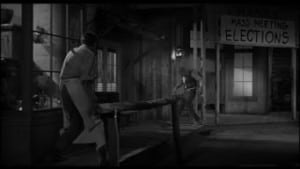 At a town gathering to elect two delegates to the statehood convention, the proceedings are interrupted by Valance, who attempts to impose his own candidacy. Doniphon nominates Stoddard, who is chosen along with Peabody, enraging Valance who challenges Stoddard to a gunfight. Stoddard stands up to Valance, saying a gunfight would flout his belief in the law.
At a town gathering to elect two delegates to the statehood convention, the proceedings are interrupted by Valance, who attempts to impose his own candidacy. Doniphon nominates Stoddard, who is chosen along with Peabody, enraging Valance who challenges Stoddard to a gunfight. Stoddard stands up to Valance, saying a gunfight would flout his belief in the law.
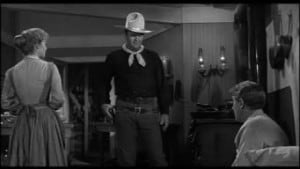 That night, Valance and his gang beat up Peabody and vandalize his office. Enraged, though knowing he is violating his principles, Stoddard confronts Valance on the boarded sidewalk of the town. Valance first shoots a hanging pot near his opponent’s head and then his right arm. Stoddard drops his gun. The outlaw lets him retrieve it before bragging his next shot will be right between the eyes. Stoddard, however, is somehow able to fire first—with his left hand, now—and Valance is shot. In an almost ballet-like sequence, he first drops to his knees, struggles to a half stance, staggers into the street, then sprawls awkwardly on the ground, dead.
That night, Valance and his gang beat up Peabody and vandalize his office. Enraged, though knowing he is violating his principles, Stoddard confronts Valance on the boarded sidewalk of the town. Valance first shoots a hanging pot near his opponent’s head and then his right arm. Stoddard drops his gun. The outlaw lets him retrieve it before bragging his next shot will be right between the eyes. Stoddard, however, is somehow able to fire first—with his left hand, now—and Valance is shot. In an almost ballet-like sequence, he first drops to his knees, struggles to a half stance, staggers into the street, then sprawls awkwardly on the ground, dead.
When Hallie lovingly administers to Stoddard’s wound, the observant Doniphon, apologizing for arriving “too late” to help Ransom, realizes she must love the lawyer. He returns drunk to his ranch and angrily sets fire to the addition he had built for the two of them. He is pulled alive from the flames by Pompey.
 At the statehood convention, Stoddard is elected as territorial delegate to Washington. When he declines, Doniphon confides to him that he, Doniphon, had actually shot Valance, firing from an alley simultaneously with Stoddard’s wild shot (shown in a brief, economically Fordian flashback). Stoddard now accepts the nomination.
At the statehood convention, Stoddard is elected as territorial delegate to Washington. When he declines, Doniphon confides to him that he, Doniphon, had actually shot Valance, firing from an alley simultaneously with Stoddard’s wild shot (shown in a brief, economically Fordian flashback). Stoddard now accepts the nomination.
The flashback and Stoddard’s story have ended. He updates those around the old stagecoach—his marriage to Hallie and his impressive political career. Knowing the truth now about who shot Liberty Valance, reporter Scott tears up his notes from the interview. “This is the West, sir,” he says. “When the legend becomes fact, print the legend.” Returning to the three mourners, Stoddard finds a cactus rose plant sitting on the lid of the coffin.
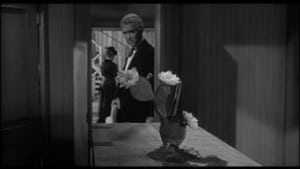 In the final scene, now on the train leaving Shinbone after the funeral, Stoddard tells Hallie he’s decided to retire from politics and return to Shinbone and practice law. He asks if she had placed the cactus rose on Doniphon’s coffin. She says she had, which gives Stoddard pause: perhaps Hallie was in love with Doniphon all along.
In the final scene, now on the train leaving Shinbone after the funeral, Stoddard tells Hallie he’s decided to retire from politics and return to Shinbone and practice law. He asks if she had placed the cactus rose on Doniphon’s coffin. She says she had, which gives Stoddard pause: perhaps Hallie was in love with Doniphon all along.
The train moves away, across the wide expanse of the plains.
All the actors in the film generally work within an harmonious and convincing ensemble, the way Ford had planned and expected. John Wayne, as always, since this is, after all, his story, easily has the most memorable part, though his scenes are fewer than Stewart’s. Wayne does well. He is forceful and larger than life, never moving much beyond the guise of John Wayne—but who cares?!
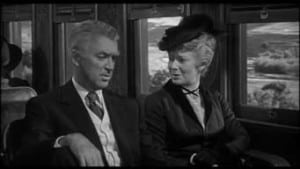 Stewart’s character is properly a little haughty in the beginning, as he returns to Shinbone in what he undoubtedly regards as something of a triumphant homecoming, now a senator and a three-time governor. In the flashback middle portion of the film—occupying a good three-quarters of the time—he is appropriately more animated; he is supposed to be twenty-five years younger, a newly trained lawyer, though the actor was, at the time, fifty-four. Rather subdued and reflective in the end, he is perhaps reminded afresh, after telling his story, that his fame as “the man who shot Liberty Valance” was based on a lie.
Stewart’s character is properly a little haughty in the beginning, as he returns to Shinbone in what he undoubtedly regards as something of a triumphant homecoming, now a senator and a three-time governor. In the flashback middle portion of the film—occupying a good three-quarters of the time—he is appropriately more animated; he is supposed to be twenty-five years younger, a newly trained lawyer, though the actor was, at the time, fifty-four. Rather subdued and reflective in the end, he is perhaps reminded afresh, after telling his story, that his fame as “the man who shot Liberty Valance” was based on a lie.
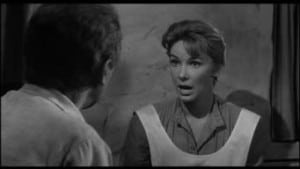 Vera Miles, as always, renders a soft, sincere performance. Although lovely as ever, she receives no special attention from Clothier’s camera, unlike John Wilcox in A Touch of Larceny (1959)—a personal favorite—whose camera embraces her with an almost Hitchcockian obsession. Speaking of whom, Hitch photographed and dressed Miles dowdily in Psycho (1960) as revenge for inconsiderately becoming pregnant and disrupting his movie plans. Such tactics were easily within John Ford’s purview, but his cruelty and psychological abuse of actors was limited to off-screen, nothing that would endanger what appeared on screen.
Vera Miles, as always, renders a soft, sincere performance. Although lovely as ever, she receives no special attention from Clothier’s camera, unlike John Wilcox in A Touch of Larceny (1959)—a personal favorite—whose camera embraces her with an almost Hitchcockian obsession. Speaking of whom, Hitch photographed and dressed Miles dowdily in Psycho (1960) as revenge for inconsiderately becoming pregnant and disrupting his movie plans. Such tactics were easily within John Ford’s purview, but his cruelty and psychological abuse of actors was limited to off-screen, nothing that would endanger what appeared on screen.
The first display of over-acting is committed by Lee Marvin, though, granted, his is a one-dimensional character, the personification of evil with no redeeming qualities; still, he gives the prostrate Stoddard at least six lashes with his silver-trimmed whip, which seems, even for him, excessive. Edmond O’Brien is critically close to going over the top, though his part does call for bluster; his character is occasionally drunk and quotes Shakespeare’s Henry V with an extravagant delivery.
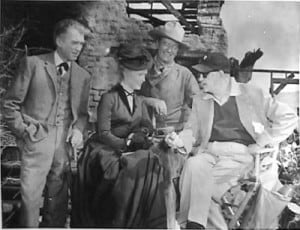 The score for Liberty Valance entertains and flavors on different levels, mostly with secondhand music. First, as in most John Ford films, certainly the Westerns, there is the typical source music and the tunes in the soundtrack—popular, folk and traditional songs of the nineteenth century, which were dear to Ford’s heart. A few of the tunes include “Oh, My Darlin’,” “Camptown Races,” “Hail! Hail! The Gang’s All Here” (from Gilbert and Sullivan’sThe Pirates of Penzance) and at least two anachronistic songs written after the time of the film, “Home on the Range” and the ragtime “A Hot Time in the Old Town.” Of central importance is “Sweet Genevieve,” introduced on Doniphon’s first appearance and serving as his leitmotiv throughout the film.
The score for Liberty Valance entertains and flavors on different levels, mostly with secondhand music. First, as in most John Ford films, certainly the Westerns, there is the typical source music and the tunes in the soundtrack—popular, folk and traditional songs of the nineteenth century, which were dear to Ford’s heart. A few of the tunes include “Oh, My Darlin’,” “Camptown Races,” “Hail! Hail! The Gang’s All Here” (from Gilbert and Sullivan’sThe Pirates of Penzance) and at least two anachronistic songs written after the time of the film, “Home on the Range” and the ragtime “A Hot Time in the Old Town.” Of central importance is “Sweet Genevieve,” introduced on Doniphon’s first appearance and serving as his leitmotiv throughout the film.
Although the score is credited on screen to the longtime American resident, the British-born Cyril Mockridge, the two most impressive musical moments in the score itself belong to Alfred Newman, borrowed from another Ford picture, Young Mr. Lincoln of 1939. The main title is a typical, easily recognized Newman march. He is famous for them, most notably “Conquest” from Captain from Castile (1947). The fervor and lyricism of the march heard here recall two scores in particular—the rhythmic verve of The Bravados (1958) and the sentiment of Brigham Young (1940).
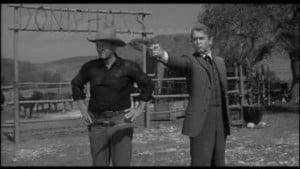 The most moving moment from the Newman score is that which represents AbrahamLincoln’s first love, Ann Rutledge, first used early in Liberty Valance when Hallie goes to Tom’s burnt-out cabin. This quiet, beautifully scored section, with its sad cello solo, reappears later when Hallie administers to Ransom’s arm wound after the gunfight.
The most moving moment from the Newman score is that which represents AbrahamLincoln’s first love, Ann Rutledge, first used early in Liberty Valance when Hallie goes to Tom’s burnt-out cabin. This quiet, beautifully scored section, with its sad cello solo, reappears later when Hallie administers to Ransom’s arm wound after the gunfight.
Confidentially, I’ve often wondered if Ford was telling his audience through the second appearance of this music, and its association with Tom’s cabin, that it was Doniphon who had killed Liberty Valance, before he revealed it himself. I’m somewhat doubtful, however: first, because it would seem an unnecessary redundancy; second, I don’t believe Ford’s mind, however creative, worked in exactly that way. Still . . . it’s something to consider.
I saw the film for the first time last night. Great movie!
Interestingly, during the scene where Tom Doniphon schools Ransom Stoddard on shooting, I noticed that Stoddard handled the pistol favoring his left hand until Doniphon instructed him to shoot the paint cans. He then switched the gun to his right hand and missed.
This may not seem consequential, however, during the confrontation betweern Stoddard and Valance, Stoddard attempts to shoot Valance holding the gun in his right hand and is wounded in the right arm. He then retrieves the gun with his left hand, fires and Valance is mortally wounded. As a result, I believe it was Stoddard who shot Valance and that Doniphon is simply seeking to ease his conscience.
If my premise is true, it squares with Stoddard’s strategic nature: the fact he can envision statehood, the need for education and the importance of representation. His handling of the gun with his right hand may have been intentional to deceive Valance, with whom a confrontation was inevitable.